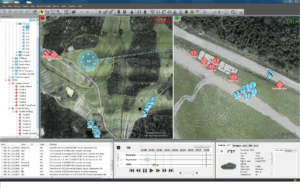London, England / Syndication Cloud / October 29, 2025 / DigitalBiz Limited

Key Takeaways
- AI models prioritize content structure and clarity over keyword density – Unlike traditional SEO, LLM optimization focuses on hierarchical organization, quantified claims, and direct answers.
- Quantified claims get cited more often than general assertions – AI systems favor concrete, specific information with real numbers and worked examples.
- Content with clear hierarchies receives significantly more citations – Semantic headers and well-structured information dramatically increase citation likelihood.
- Platform-specific strategies are essential – Each AI model has different trust signals and source selection processes that require tailored approaches.
- LLMO delivers substantially better visibility than traditional SEO – Large Language Model Optimization addresses content gaps and uses pattern recognition across AI platforms.
The digital landscape is shifting dramatically as AI search traffic is projected to surpass traditional search between 2026-2030. Content creators and marketers who understand how to structure content for AI citation are already seeing remarkable results, while others struggle to maintain visibility in an increasingly AI-driven information ecosystem.
AI Models Prioritize Specific Content Formats Over Keywords
The traditional approach of keyword stuffing and backlink building is becoming obsolete in the world of AI-powered search. Large Language Models like Claude and Perplexity operate on fundamentally different principles than Google’s traditional ranking algorithms. These AI systems prioritize content relevance, authority, and clarity over keyword density and link profiles.
LLMs favor credible sources with expert opinions and reputable citations, focusing on content that directly addresses user queries with actionable answers. This shift represents a move from gaming search algorithms to genuinely serving user intent through high-quality, well-structured information.
As DigitalBiz explains, this transformation requires content creators to rethink their entire approach. Instead of optimizing for search engine crawlers, successful content now needs to speak directly to AI models that analyze context, meaning, and value rather than simple keyword matches.
Essential Structure Elements That Increase Citation Likelihood
1. Clear Hierarchical Organization With Semantic Headers
Content with clear hierarchies receives citations at significantly higher rates than poorly organized material. AI models scan for semantic headers that provide context and structure, making it easier for them to understand and reference specific information. Headers should follow a logical progression from H1 through H4, with each level providing increasingly specific information.
Effective semantic headers use natural language that matches how users phrase questions. Instead of keyword-stuffed headers like “Best SEO Tips Keywords Strategy,” use clear, descriptive headers such as “How to Research Keywords for Higher Search Rankings.” This approach aligns with how AI models process and categorize information.
2. Quantified Claims and Data-Driven Statements
Quantified claims receive more citations than general assertions because AI systems gravitate toward concrete, specific information. Instead of writing “many businesses see improvement,” specify “73% of businesses report a 25% increase in conversions within 90 days.” This specificity provides AI models with reliable data points they can confidently reference.
Data-driven statements should include the source of information, methodology when relevant, and time frames for the data. AI models favor recent, well-sourced statistics that add credibility to their responses. Always pair quantified claims with context that explains their significance and practical applications.
3. FAQ Sections With Direct Q&A Pairs
FAQ-style content provides direct answers to specific questions, which AI models highly value when generating responses. These sections should use conversational language that mirrors how users naturally ask questions, followed by complete yet concise answers.
Structure FAQs with clear question headers followed by complete answers that can stand alone. AI assistants often pull entire FAQ responses, so ensure each answer includes necessary context without requiring additional information from other sections of the content.
Technical Requirements for AI Crawler Access
Robots.txt Configuration: Controlling Bot Access and Permissions
Proper robots.txt configuration ensures AI crawlers like GPTBot and OAI-SearchBot can access your content effectively. Unlike traditional search engine bots, AI crawlers require specific permissions to index content for citation purposes. Configure your robots.txt file to allow these specialized bots while maintaining control over which pages they can access.
Create clear pathways for AI crawlers by avoiding restrictive disallow statements that might block important content. Consider creating a dedicated sitemap for AI crawlers that highlights your most citation-worthy content, including FAQ sections, data-rich articles, and evergreen reference materials.
Schema Markup Implementation for Context
Schema markup provides essential context that AI crawlers use to understand and categorize your content. Implement structured data using schema.org markup to clearly define article types, author information, publication dates, and content categories. This structured approach helps AI models determine the authority and relevance of your content.
Focus on the FAQ schema, the article schema, and the organization schema to maximize AI understanding. These markup types directly correspond to the information AI models seek when building citations and references. Proper implementation significantly improves the likelihood of citation by providing clear context about your content’s purpose and authority.
Platform-Specific Citation Strategies
Claude’s Authority Signal Preferences
Claude prioritizes content from sources that demonstrate clear expertise and authoritativeness. The platform favors academic-style citations, peer-reviewed information, and content that includes author credentials and institutional affiliations. To increase Claude citations, focus on creating content that resembles academic or professional research in structure and sourcing.
Include detailed author bios, cite reputable sources throughout your content, and use formal language that conveys expertise. Claude also responds well to content that acknowledges limitations, presents balanced perspectives, and includes methodological details when discussing research or data.
Perplexity’s Curated Source Selection Process
Perplexity AI operates differently from other platforms by sourcing information from a carefully curated selection of reputable sources using real-time web search rather than crawling the entire web. This selective approach means earning a place in Perplexity’s trusted source network requires exceptional content quality and consistent authority signals.
Focus on building domain authority through consistent publication of high-quality, well-researched content. Perplexity favors sources that maintain editorial standards, fact-check information, and provide transparent sourcing. Regular publication schedules and consistent quality help establish the trust signals necessary for inclusion in Perplexity’s curated network.
Content Distribution Beyond Your Website
1. High-Authority Publishing Platforms (Medium, LinkedIn)
Publishing on high-authority platforms like Medium and LinkedIn significantly increases the likelihood of AI citation. These platforms carry inherent trust signals that AI models recognize and favor. When republishing content on these platforms, adapt it specifically for each platform’s audience while maintaining the core structure and data that make it citation-worthy.
Focus on platforms where your target audience naturally seeks information. LinkedIn works exceptionally well for B2B content, while Medium serves broader audiences seeking in-depth, well-researched articles. Maintain consistent authorship across platforms to build recognition and authority that AI models can associate with your expertise.
2. Community Engagement Hubs (Reddit, Quora)
AI tools frequently pull content from community platforms like Reddit and Quora, making these valuable channels for increasing citation opportunities. Engage authentically in these communities by providing detailed, helpful answers that showcase your expertise without overt self-promotion.
Focus on answering questions in your area of expertise with detailed responses that include data, examples, and actionable advice. These detailed community contributions often become source material for AI models when users ask related questions, creating valuable citation opportunities that drive brand awareness.
3. Multi-Channel Presence Strategy
Developing a multi-channel presence ensures your content appears across the diverse range of sources AI models access. This strategy involves adapting core content for different platforms while maintaining consistency in key messages and data points.
Create a content distribution calendar that strategically places your most citation-worthy content across multiple channels. This approach increases the probability that AI models will encounter and cite your information, while also building the wide online presence that signals authority to these systems.
LLMO Strategies Drive Measurable Visibility Gains Over Traditional SEO
Large Language Model Optimization (LLMO) represents a fundamental shift from traditional SEO practices, delivering measurable improvements in brand visibility and citation frequency. Studies show that LLMO strategies can boost visibility substantially compared to keyword-only SEO approaches by using content analysis and pattern recognition across various AI platforms.
The key difference lies in LLMO’s focus on content quality and structure rather than search engine manipulation. While traditional SEO often involves optimizing for specific algorithms, LLMO creates genuinely valuable content that serves user intent across multiple AI platforms simultaneously.
Success in LLMO requires consistent measurement and adaptation. Track citation frequency across different AI platforms, monitor brand mentions in AI-generated responses, and analyze which content formats generate the most citations. This data-driven approach allows continuous refinement of content strategies to maximize AI visibility and citation opportunities.
DigitalBiz Limited
Initial Business Centre
207 Regent Street
London
England
W1B 3HH
United Kingdom



















